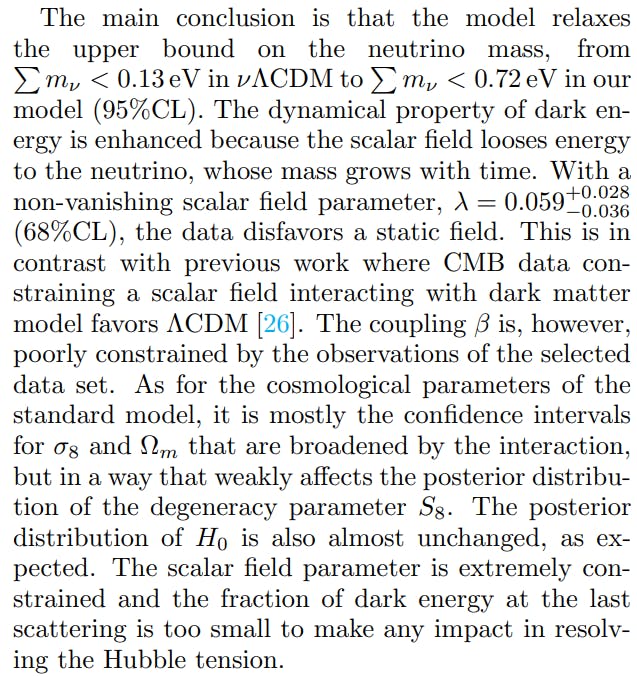
2024-5-24 22:0:22 Author: hackernoon.com(查看原文) 阅读量:0 收藏
This paper is available on arxiv under CC 4.0 license.
Authors:
(1) Vitor da Fonseca, Instituto de Astrof´ısica e Ciˆencias do Espa¸co, Faculdade de Ciˆencias da Universidade de Lisboa;
(2) Tiago Barreiro, Instituto de Astrof´ısica e Ciˆencias do Espa¸co, Faculdade de Ciˆencias da Universidade de Lisboa and 2ECEO, Universidade Lus´ofona;
(3) Nelson J. Nunes, Instituto de Astrof´ısica e Ciˆencias do Espa¸co, Faculdade de Ciˆencias da Universidade de Lisboa.
Table of Links
- Abstract and Intro
- Coupling Dark Energy to Neutrinos
- Impact of the Coupling on Perturbations and Observables
- Parameter Estimation
- Discussion
- Acknowledgment, Appendix, and References
V. DISCUSSION
In this study, we investigated a model of massvarying neutrinos in which the mass depends on the value of a scalar field representing the dark energy component. The originality of our work lies in the choice of the quintessence parametrization, which limits the number of free parameters with respect to other approaches such as the CPL parametrization or arbitrary choices of scalar field potentials. While the parametrization is purely phenomenological, it leads to the analytical reconstruction of the potential as a sum of exponential terms, which conveniently endows dark energy with scaling properties. We have introduced two additional free parameters with respect to ΛCDM, β for the coupling strength between the two sectors in Eq. (2.2) and λ for the linear evolution of the field in Eq. (2.9).

We confirmed the conjecture that a growing neutrino mass scenario relaxes the upper bound on the current neutrino mass derived in the framework of the baseline νΛCDM model. Our goal was to complement previous work, such as the study in Ref. [16]. In the latter, one of the models considered by the authors was a mass-varying neutrino theory with a constant coupling to the scalar field and a quintessential potential in the form of an exponential. In contrast to our case, their model shows no tracking behavior and allows only shrinking mass scenarios. They also found that astronomical observations do not provide strong constraints on the coupling parameter. To constrain the coupling, they fixed the neutrino mass to values higher than 0.1 eV, assuming that such a significant mass could be independently confirmed. Alternately, in our likelihood analysis, we set different values of the coupling to constrain the current neutrino mass.
Following the analysis of the model at background level, we evaluated the sensitivity of several observables (matter and CMB power spectra, and CMB lensing potential) to the coupling, using a version of the Boltzmann code CLASS that we adapted to the considered model. We found that growing neutrino masses lead to less matter power suppression than predicted by the presence of a non-interacting scalar field. The coupling also affects the shape of the CMB power spectrum at different scales, in particular through the integrated Sachs-Wolf effect, in parallel with the effect of the scalar field parameter itself. The CMB lensing potential is sensitive to the interaction. Growing neutrino masses can compensate for the reduction in lensing potential caused by the quintessence fluid. It is therefore theoretically possible to obtain constraints on a putative interaction between the neutrino sector and a dynamical dark energy component.


In what respects future work, it would be worthwhile to complement the CMB constraints that the Planck data place on the parameters of our model with precise measurements of the anisotropies at larger multipoles (l ≳ 3000). These small angular scales measured with sufficient accuracy can reveal coupling signatures, especially when the strength of the interaction is small [73]. For example, an indication of nonvanishing coupling between neutrinos and dark matter at the one-sigma level has been found using the Atacama Cosmology Telescope’s (ACT) high-multipole observations of CMB temperature and polarization anisotropies [74]. In addition, alternative CMB data on the lensing power spectrum could also be used to further constrain the neutrino – scalar field interaction scenario affecting structure growth [75]. As for the late-time universe probes of large-scale structure, it would be adequate to use the KiDS weak lensing observations [76] to test the MaVaN model, like in the coupled dark matter case [26].
如有侵权请联系:admin#unsafe.sh